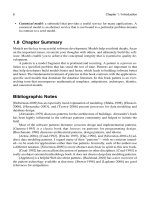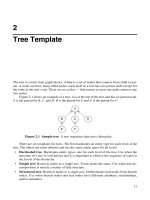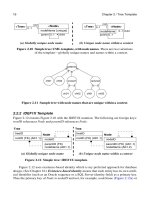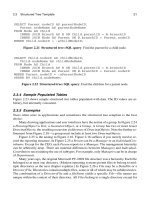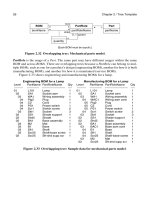PATTERNS OF DATA MODELING- P26 ppsx
Bạn đang xem bản rút gọn của tài liệu. Xem và tải ngay bản đầy đủ của tài liệu tại đây (144.73 KB, 5 trang )
108 Chapter 8 / Universal Antipatterns
Figure 8.13 shows a table from another application. I am not sure what the attributes
mean. My best guess is that this table was being used for populating a spreadsheet.
Figure 8.12 Paradigm degradation: Fixed three-level hierarchy.
Level 3 table
internid
changedate
changetime
pointer1
pointer2
Level 2 table
internid
changedate
changetime
pointer1
Level 1 table
internid
changedate
changetime
Antipattern example
Figure 8.13 Paradigm degradation: Spreadsheet as a giant table.
Avoid distortions of a relational database.
d100
d200
d300
d400
d500
d600
d705
d710
d720
d725
d740
d750
d775
d790
h200
h300
h400
h705
h710
h720
h725
h740
h750
h790
Antipattern example
8.10 Chapter Summary 109
8.10 Chapter Summary
An antipattern is a characterization of a common software flaw. As you construct models,
you should be alert for antipatterns and correct them. Table 8.1 summarizes universal anti-
patterns—antipatterns to always avoid—along with their exceptions and resolution.
Bibliographic Notes
[Brown-1998] discusses antipatterns for programming, architecture, and management. The
book is informative, but the authors oversell the technology—antipatterns are not a panacea
for the difficulties of software development. As [Brooks-1987] notes, there is no silver bullet
Antipattern
name
Observation Exceptions Resolution Frequency
Symmetric
relationship
A self relation-
ship has the same
multiplicity and
roles on each end.
None Promote the rela-
tionship to an
entity type.
Common
Dead
elements
A model has
unused elements.
Acceptable in
small amounts.
Delete them or
isolate them.
Common
Disguised
fields
Field names do
not describe data.
A few user-
defined fields.
Use meaningful
names.
Common
Artificial
hardcoded
levels
There is a fixed
hierarchy of simi-
lar entity types.
Use only with
great caution.
Consolidate the
levels and use a
tree pattern.
Occasional
Excessive
generalization
There is a deep
generalization.
None A db taxonomy
should be at most
four levels deep.
Occasional
Disconnected
entity types
A model has free-
standing entity
types.
A few can be
acceptable.
Add the missing
relationships.
Occasional
Modeling
errors
There is a serious
conceptual flaw.
None Fix the model. Occasional
Multiple
inheritance
A model has mul-
tiple inheritance.
Avoid for data
models.
Use a work-
around.
Seldom
Paradigm
degradation
A relational db is
degraded to some
other paradigm.
Highly question-
able.
Rework the
model and archi-
tecture.
Seldom
Table 8.1 Summary of Universal Antipatterns
110 Chapter 8 / Universal Antipatterns
for improving software quality. [Laplante-2006] builds on [Brown-1998] and adds further
management antipatterns as well as cultural antipatterns.
Many of the examples in this chapter came from my experiences with database reverse
engineering — starting with existing database structures and inferring the underlying mod-
els. [Premerlani-1994] and [Blaha-1995] present unusual database designs that were found
during reverse engineering.
References
[Americazoo] />[Blaha-1995] Michael Blaha and William Premerlani. Observed idiosyncrasies of relational database
designs. Second Working Conference on Reverse Engineering, July 1995, Toronto, Ontario, 116–
125.
[Blaha-2003] Michael Blaha. Data store models are different than data interchange models. Proceed-
ings of the International Workshop on Meta-Models and Schemas for Reverse Engineering (ateM
2003), November 2003, Victoria, BC.
[Blaha-2006] Michael Blaha. Designing and Implementing Softcoded Values. IEEE Computer Society
ReadyNote, 2006.
[Brown-1998] William J. Brown, Raphael C. Malveau, Hays W. “Skip” McCormick, and Thomas J.
Mowbray. AntiPatterns: Refactoring Software, Architectures, and Projects in Crisis. New York:
John Wiley & Sons, Ltd, 1998.
[Brooks-1987] Frederick P. Brooks, Jr. No silver bullet: Essence and accidents of software engineer-
ing. IEEE Computer 20, 4 (April 1987), 10–19.
[Laplante-2006] Phillip A. Laplante and Colin J. Neill. Antipatterns: Identification, Refactoring, and
Management. Boca Raton, FL: Auerbach Publications, 2006.
[Premerlani-1994] William Premerlani and Michael Blaha. An approach for reverse engineering of re-
lational databases. Communications ACM 37, 5 (May 1994), 42–49.
111
9
Non-Data-Warehouse Antipatterns
Most applications rely on their database structure to help enforce data quality. Data ware-
house applications are an exception—a data warehouse emphasizes the reading of data and
makes data quality the responsibility of loading programs. The antipatterns in this chapter
simplify reading but compromise the ability of database structure to enforce quality. Hence,
these antipatterns are acceptable for data warehouses, but you should avoid them otherwise.
9.1 Derived Data Antipattern
9.1.1 Observation
A model has elements (entity types, relationships, attributes) that are not fundamental. These
elements can be computed from other elements and lack substance in their own right. De-
rived data can complicate development and increases the likelihood of data corruption.
9.1.2 Exceptions
Consider using derived data for critical application elements or to resolve performance bot-
tlenecks. For example, it is faster to store the current security positions for a broker account,
than to compute them by processing past transactions. Derived data is often used for data
warehouses to speed performance and ease the writing of queries.
9.1.3 Resolution
When possible, rework the model to eliminate derived elements. Otherwise carefully docu-
ment derived data and pay special attention to checking for inconsistencies in your test plan.
Sometimes it is helpful to use a generic mechanism to keep derived data consistent with base
data—for example, it is entirely acceptable to have derived data that is computed via a
database view.
112 Chapter 9 / Non-Data-Warehouse Antipatterns
9.1.4 Examples
In Figure 9.1 it is much better to include a person’s birthdate rather than age which changes
over time. The original model is also undesirable for a data warehouse.
Figure 9.2 and Figure 9.3 show a partial model for a library. The slash prefix in Figure
9.2 is UML notation for derived data. The dueDat e can be computed from checkoutDate and
checkoutPeriod. The calculate dFine is computed according to the formula. Figure 9.4 shows
SQL Server code for the calculations.
Person
name
(a) Antipattern example (b) Improved model
address
age
Person
name
address
birthdate
Figure 9.1 Derived data: UML person model. Try to avoid derived data
and focus on fundamental data.
{calculatedFine = (returnDate - dueDate) * finePerDayOverdue}
Figure 9.2 Derived data: UML library model. If you do use derived data,
then carefully document it.
{ordered}
LibraryItem
name
replacementCost
Author
name
LibraryItemType
name
checkoutPeriod
maxRenewalsPermitted
finePerDayOverdue
libraryPatron
Person
name
address
phoneNumber
LibraryCard
expirationDate
Library
name
Checkout
checkoutDate
finePaid
LibraryItemCopy
copyNumber
PendingRequest
requestDate
cardNumber
*
**
1
*
1
*
1
1
*
*
1
1
*
1
*
1
*
1
0 1
CheckoutItem
/dueDate
returnDate
/calculatedFine
1
*



